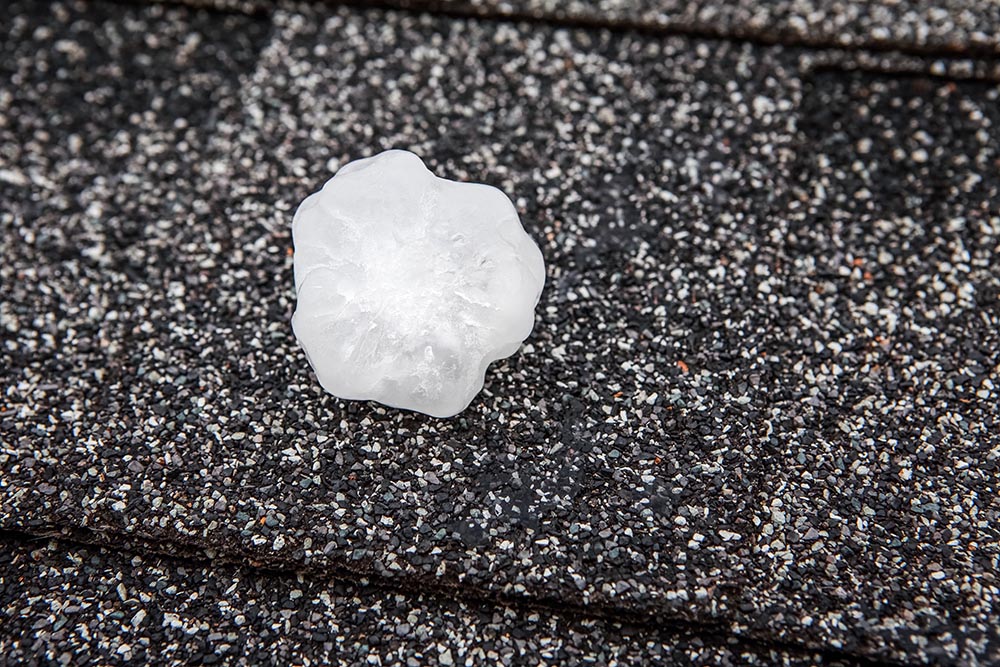When it comes to your home, the roof reigns supreme when it comes to importance in its construction. It is the first defense against the weather and is responsible for facilitating proper insulation and protection from the weather and outside threats. It’s also a huge part of your home’s exterior aesthetic design and curb appeal, so taking care of it is a big deal.
Some types of weather can leave a lasting impact on your rooftop that compromises its ability to protect, insulate, and look great. In situations like these, immediate repair or replacement is usually necessary, depending on the severity of the damage. One example common in Missouri is the hailstorm. Hail can fall in a range of sizes from a small pebble to larger than a baseball, and the impact of these balls of ice falling onto your home and property can be enormous.
Hailstorms are common in the Midwest and the USA. In fact, over 5,300 hail events were recorded in 2019 alone. With such damage possible occurring at any moment, it can be challenging to know exactly what to do after a hailstorm. Here’s what Kansas City homeowners living in the “Hail Alley” section of the country need to know.
After the Hailstorm
The key to dealing with a hailstorm is to work with a sense of urgency. Even if the damage isn’t immediately noticeable, that doesn’t mean there isn’t damage to report. As such, once the storm has passed and it’s safe to go outside, you must do the following:
- Check for damage: Make sure you evaluate for even the smallest signs of damage. A minor tear today could equal a major leak down the road. If the roof has been compromised, then problems such as rain, wind, or snow can get under the roof and into your home, which leads to more damage than you started with.
- Evaluate the gutters: The gutter system helps drain the excess water down and away from the building. When compromised, the gutters can make your roof situation worse. Look for large cracks or dents when inspecting your gutters, and invest in high-quality, steel mesh gutter guards if you haven’t already.
- Make note of the time and date: To get an insurance claim approved, you’ll need to be able to verify the time and date of the hailstorm.
- Record the property: Highlighting the damage to your roof becomes easier when it’s compared to the rest of the property. Take pictures of any hailstones present on the property. Make sure to highlight its size to further emphasize the damage. If during the inspection, you notice leaks around the house, it pays to take a picture of this as well.
- Check for emergency states: Leaks in the roof or broken windows need a quick fix at the minimum to ensure everyone stays safe while you do what’s needed to file a claim.
- File the claim: Ideally, you get a roofing contractor to help validate the damage, but the main focus is to file the claim with your insurance company as quickly as possible to ensure the best chances of getting approved. Make sure to have your contractor meet with the insurance claims adjuster if possible.
Filing a Successful Claim
The good news is that hail damage is a pretty standard weather event to cover, which means it’s likely your home insurance will take care of you in this event. However, it’s important to remember that no two policies are the same. Carefully evaluate how the coverage is applied and what’s needed to satisfy the requirements. For example, maybe you need to pay a deductible first, or the policy will only cover roof replacement but not repairs.
Filing a claim can be tricky so we’ve put together a few things to keep in mind for your review:
- When it’s time to file: The sooner the better is the course of action to take. Most policies allow up to one year after a hailstorm to file the claim. However, the longer you delay in filing, the harder it will be to prove the hailstorm damaged your roof.
- Check the coverage amount: Sometimes, it’s not worth filing the claim. If your deductible is too high compared to the amount it’ll take to fix the damage then going a different route may be better. As long as the fix is worth it in the long run, feel free to file that claim.
- Be wary of cosmetic damage: Most insurers have an exclusion clause in their policy that allows them to deny insurance claims when the damage is deemed to be merely cosmetic. As such, it’s prudent to have your contractor evaluate and document all signs of damage especially any that goes beyond cosmetic damage.
What Your Contractor Does
By far, a reputable contractor is your best weapon in getting your insurance claim approved. The first thing to do is to get a contractor (or three or four) to come out and inspect the roof for damage. This inspection should be free since they’d expect to get paid from your insurance company. Before you choose the first contractor you find, it’s important to understand the following:
- Make sure they’re licensed & insured: Most cities require a permit in order to replace your roof, so its important that you choose a contractor that has the proper licensing and insurance required to pull the permit.
- Your presence is necessary: When scheduling the appointment, you must be home during the inspection. While going through the inspection make it clear that repairs won’t happen at that time. If you’ve already observed damage, be sure to point those spots out specifically.
- The contractor is your ally: Insurance companies will pay to replace or repair your roof. However, they only want to pay what they have to. An example of this would be the insurance company approving to cover $10,000 of damage. However, if you have a qualified contractor turning in an estimate that says repairs will cost $25,000 that coverage amount wouldn’t suffice. Ultimately, your contractor will help you force the insurance company to be honest with their coverage amount.
If you’re ready to check on your roof replacement options, then give us a call to speak with one of our agents about our roof installation services or fill out our online form to schedule your free, in-home assessment.

